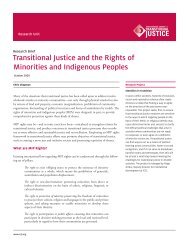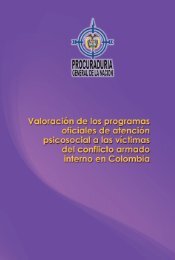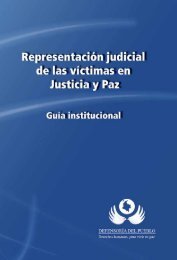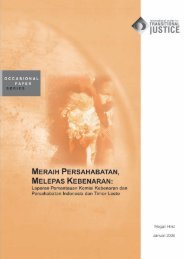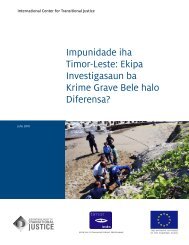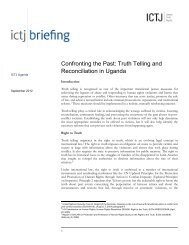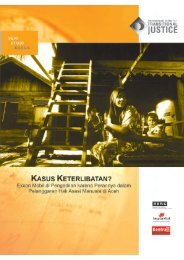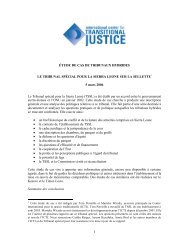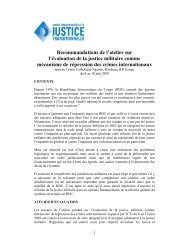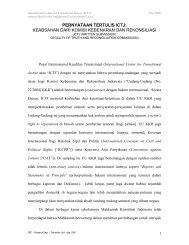That Someone Guilty Be Punished - International Center for ...
That Someone Guilty Be Punished - International Center for ...
That Someone Guilty Be Punished - International Center for ...
You also want an ePaper? Increase the reach of your titles
YUMPU automatically turns print PDFs into web optimized ePapers that Google loves.
tation of the Peace Agreement to the Secretary-General of the United Nations, 28 (May 14, 2002), at<br />
http://www.ohr.int/print/?content_id=8069. Their analysis and recommendations are discussed in<br />
depth in Bohlander, supra, at 66–85. Then ICTY President Claude Jorda presented the broad outlines<br />
of this proposal to the UN Security Council on July 23, 2002. See Address by His Excellency,<br />
Judge Claude Jorda, President of the <strong>International</strong> Criminal Tribunal <strong>for</strong> the <strong>for</strong>mer Yugoslavia, to<br />
the United Nations Security Council, July 23 2002, ICTY Press Release JDH/P.I.S./690-e (July 26,<br />
2002), at http://www.icty.org/sid/8080. Following his remarks, the Security Council “endorse[d]<br />
the report’s broad strategy <strong>for</strong> the transfer of cases involving intermediary and lower-level accused<br />
to competent national jurisdictions as likely to be in practice the best way of allowing the ICTY to<br />
achieve its current objective of completing all trial activities at first instance by 2008.” SC Press<br />
Release 7461, at http://www.un.org/News/Press/docs/2002/sc7461.doc.htm. In his memoir, <strong>for</strong>mer<br />
High Representative Paddy Ashdown recalled that on November 19, 2002, then ICTY Prosecutor<br />
Carla Del Ponte “visited Sarajevo and we took the historic decision (private <strong>for</strong> the moment)<br />
that we would take on the task of establishing a domestic war crimes chamber in Bosnia. This $25<br />
million project would give Bosnia a mini-Hague court and make it the first country in the Balkans<br />
to be able to try its own war criminals in its own specialized court, on its own territory.” Paddy<br />
Ashdown, Swords and Plowshares: Bringing Peace to the 21st Century, p. 256.<br />
763. The OHR’s re<strong>for</strong>ms “essentially moved the country away from its traditional civil law model<br />
to one closer to the adversarial system.” Tolbert and Kontić, Transitional Justice, supra, p. 147. By<br />
equal measure, accommodating the ICTY’s criteria <strong>for</strong> a trustworthy local partner placed further<br />
demands on a judiciary that was already facing the daunting challenges presented by the OHR’s<br />
radical judicial restructuring plan. Although generally complimentary of the ICTY’s contributions<br />
to the war crimes section of the Court of BiH, Branko Perić, then president of Bosnia’s High Judicial<br />
and Prosecutorial Council (HJPC), noted that the chamber faced some challenges because “the<br />
Hague [Tribunal] was trying to solve its own problem instead of Bosnia and Herzegovina trying to<br />
solve its problems.” Interview with Branko Perić, then president, HJPC, Sarajevo, Dec. 4, 2006.<br />
764. Donlon, Rule of Law, supra, p. 277.<br />
765. Interview with Mechtild Lauth, then senior legal counsel, The Registry, War Crimes and<br />
Organized Crime, Court of BiH, Sarajevo, June 12, 2007; OSCE, Progress and Obstacles, p. 10; see<br />
also Tolbert and Kontić, Transitional Justice, supra, at 146. Although the PIC had endorsed the<br />
OHR’s comprehensive judicial re<strong>for</strong>m plan in July 2002, the war crimes chamber was not yet<br />
included in this plan. See Donlon, Rule of Law, p. 274.<br />
766. Interview with Mechtild Lauth, Sarajevo, June 12, 2007. According to then State Prosecutor<br />
Marinko Jurčević, the key law <strong>for</strong> transferring cases from the ICTY to Bosnia’s War Crimes Chamber<br />
“was not passed overnight but prior to that the working groups worked day and night” to lay<br />
the groundwork <strong>for</strong> this law. Interview with Marinko Jurčević, Sarajevo, Dec. 4, 2006.<br />
767. See Tolbert and Kontić, Transitional Justice. supra, pp. 146–47. According to various individuals<br />
involved in this process, the OHR “did much of the work” in this process.<br />
768. Donlon, Rule of Law, supra, p. 277. ICTY staff involved in the planning process were also<br />
keen to ensure that the joint ef<strong>for</strong>t led to sustainable judicial capacity-building.<br />
769. As noted earlier, the chamber is officially known as Section I of the Court of BiH.<br />
770. See id.<br />
194 NOTES




